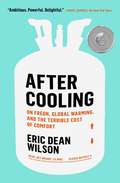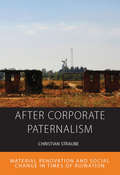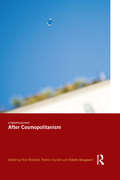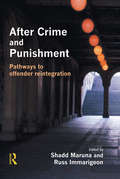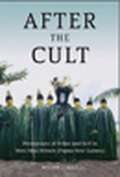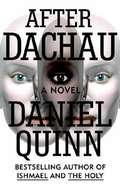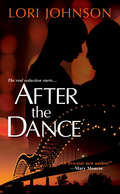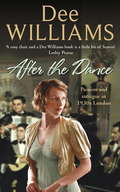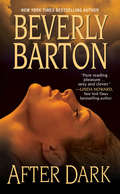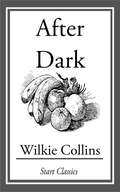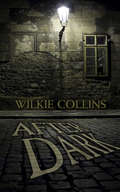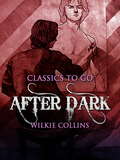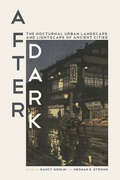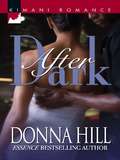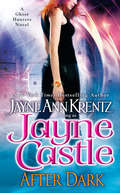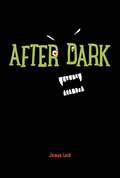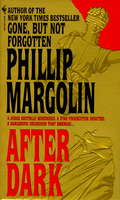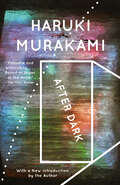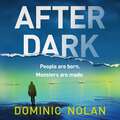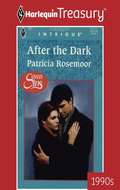- Table View
- List View
After Cooling: On Freon, Global Warming, and the Terrible Cost of Comfort
by Eric Dean WilsonThis dazzlingly original work of literary nonfiction interweaves the science and history of the powerful refrigerant (and dangerous greenhouse gas) Freon with a haunting meditation on how to live meaningfully and morally in a rapidly heating world.In After Cooling, Eric Dean Wilson braids together air-conditioning history, climate science, road trips, and philosophy to tell the story of the birth, life, and afterlife of Freon, the refrigerant that ripped a hole larger than the continental United States in the ozone layer. As he traces the refrigerant&’s life span from its invention in the 1920s—when it was hailed as a miracle of scientific progress—to efforts in the 1980s to ban the chemical (and the resulting political backlash), Wilson finds himself on a journey through the American heartland, trailing a man who buys up old tanks of Freon stockpiled in attics and basements to destroy what remains of the chemical before it can do further harm. Wilson is at heart an essayist, looking far and wide to tease out what particular forces in American culture—in capitalism, in systemic racism, in our values—combined to lead us into the Freon crisis and then out. It&’s a story that offers a rare glimpse of environmental hope, suggesting that maybe the vast and terrifying problem of global warming is not beyond our grasp to face.
After Corporate Paternalism: Material Renovation and Social Change in Times of Ruination (Integration and Conflict Studies #24)
by Christian StraubeIn this ethnographic study of post-paternalist ruination and renovation, Christian Straube explores social change at the intersection of material decay and social disconnection in the former mine township Mpatamatu of Luanshya, one of the oldest mining towns on the Zambian Copperbelt. Touching on topics including industrial history, colonial town planning, social control and materiality, gender relations and neoliberal structural change, After Corporate Paternalism offers unique insights into how people reappropriate former corporate spaces and transform them into personal projects of renovation, fundamentally changing the characteristics of their community.
After Cosmopolitanism
by Rosi Braidotti Patrick Hanafin Bolette BlaagaardAt a time when social and political reality seems to move away from the practice of cosmopolitanism, whilst being in serious need of a new international framework to regulate global interaction, what are the new definitions and practices of cosmopolitanism? Including contributions from leading figures across the humanities and social sciences, After Cosmopolitanism takes up this question as its central challenge. Its core argument is the idea that our globalised condition forms the heart of contemporary cosmopolitan claims, which do not refer to a transcendental ideal, but are rather immanent to the material conditions of global interdependence. But to what extent do emerging definitions of cosmopolitanism contribute to new representative democratic models of governance? The present volume argues that a radical transformation of cosmopolitanism is already ongoing and that more effort is needed to take stock of transformations which are both necessary and possible. To this end, After Cosmopolitanism calls for an understanding of cosmopolitanism that is more attentive to the material reality of our social and political situation and less focused on linguistic analyses of its metaphorical implications. It is the call for a cosmopolitanism that is also a cosmopolitics.
After Crime and Punishment
by Shadd Maruna Russ ImmarigeonThe issue of resettling ex-prisoners and ex-offenders into the community has become an increasingly important one on both sides of the Atlantic. In the USA the former Attorney General Janet Reno identified the issue as 'one of the most pressing problems we face as a nation' in view of the massive prison population and the rapid increase in rates of incarceration, while in the UK it has become an increasingly important issue for similar reasons, and the subject of recent reports by HM Inspectorate of Prisons and HM Inspectorate of Probation, as well as from the Social Exclusion Unit of the Home Office. Yet this issue has not been well served by the criminological literature, and the new policies and programmes that have been set up to address the problem have not been well grounded in criminological thinking. This book seeks to address the important set of issues involved by bringing together the best of recent thinking and research into desistance from crime, drawing upon research in both the UK and the USA, and with a distinct focus on how this might impact upon the design and implementation of ex-offender reintegration policy.
After The Cult
by Holger JebensIn many parts of the world the "white man" is perceived to be an instigator of globalization and an embodiment of modernity. However, so far anthropologists have paid little attention to the actual heterogeneity and complexity of "whiteness" in specific ethnographic contexts. This study examines cultural perceptions of other and self as expressed in cargo cults and masked dances in Papua New Guinea. Indigenous terms, images, and concepts are being contrasted with their western counterparts, the latter partly deriving from the publications and field notes of Charles Valentine. After having done his first fieldwork more than fifty years ago, this "anthropological ancestor" has now become part of the local tradition and has thus turned into a kind of mythical figure. Based on anthropological fieldwork as well as on archival studies, this book addresses the relation between western and indigenous perceptions of self and other, between "tradition" and "modernity," and between anthropological "ancestors" and "descendants." In this way the work contributes to the study of "whiteness," "cargo cults" and masked dances in Papua New Guinea.
After D-Day: The U.S. Army Encounters the French
by Robert Lynn FullerAfter D-Day is one of a small but growing body of works that examine the Allied liberators of France. This study focuses on both the French experience of the U.S. Army and the American soldiers’ reaction to the French during the liberation and its immediate aftermath. Drawing on French and American archival materials, as well as dozens of memoirs, diaries, letters, and newspapers, Robert Lynn Fuller follows French and American interactions, starting in the skies over France in 1942 and ending with the liberation of Alsace in 1945. Fuller pays special attention to French life in the war zones, where living under constant shelling offered a miserable experience for those forced to endure it. The French stoically withstood those travails—sometimes inflicted by the Americans—when they saw their sacrifices as the price of liberation and victory over Germany. As Fuller shows, when the French did not believe afflictions brought by the Americans advanced the cause of success, their tolerance waned, sometimes dramatically. Fuller maintains that the Allied bombing of France was an important yet often overlooked chapter of World War II, one that inflicted more death and destruction than the ground war still to come. Yet the ground campaign, which began with the Allied invasion of Normandy, unleashed enormous violence that killed, injured, or rendered homeless tens of thousands of French civilians. Fuller examines French and American records of the fate of civilians in the principal battle zones, Normandy and Lorraine, as well as in overlooked liberated regions, such as Orléanais and Champagne, that largely escaped widespread damage and casualties. Despite French gratitude toward the Americans for the liberation of their country, relations began to cool in the fall and winter of 1944 as progress on the battlefield slowed and then appeared to reverse with the German offensive in the Ardennes. Revealing in stark detail the experiences of French civilians with the American military, After D-Day presents a compelling coda to our understanding of the Allied conquest of German-occupied France.
After Dachau
by Daniel QuinnDaniel Quinn, well known for Ishmael - a life-changing book for readers the world over - once again turns the tables and creates an otherworld that is very like our own, yet fascinating beyond words. Imagine that Nazi Germany was the first to develop an atomic bomb and the Allies surrendered. America was never bombed, occupied, or even invaded, but was nonetheless forced to recognize Nazi world dominance. The Nazis continued to press their campaign to rid the planet of "mongrel races" until eventually the world - from Capetown to Tokyo - was populated by only white faces. Two thousand years in the future people don't remember, or much care, about this distant past. The reality is that to be human is to be Caucasian, and what came before was literally ancient history having nothing to do with those then living. Now imagine that reincarnation is real, that souls migrate over time from one living creature to another, and that a soul that once animated an American black woman living at the time of World War II now animates an Aryan in Quinn's new world, and that due to a traumatic accident memories of this earlier incarnation assert themselves. Compared by readers and critics alike to 1984 and Brave New World, After Dachau is a new dystopian classic with much to say about our own time, and the dynamics of human history.
After The Dance
by Lori JohnsonIt's Her Game . . . Here's my deal--I'm not knocking myself out to find Mr. Right anymore. As far as this thirty-something sistah is concerned, it's now about reciprocity, not romance. A brother doesn't have to whisper promises he won't keep or make me any kind of commitment. All he needs to do is respect my boundaries, rock my world--then step the hell on before anyone gets too attached. That's why the last man I need to be trying to hook-up with is my next door neighbor, Carl. But He's Breaking All The Rules . . . Who does Faye think she's fooling? She and I both know all that talk she does about game-playing is little more than a big front. Besides, playing by the rules won't necessarily keep us from falling in love. And if what's been going on between us lately is any indication, I'm thinking at least one of us is already halfway there. . .. "After the Dance is a fast-paced delight with a plotline so intriguing and dialogue and characters so real, I had to keep reminding myself that I was reading fiction. It is an easy read with NO dull moments. I was hooked from the first page to the last. This is a five star new story from a five star new author!" --Mary Monroe, New York Times bestselling author "Unique, interesting characters and sharp, crackling wit laced with occasional pathos make this first novel a genuine winner." --Gwynne Forster, author of Getting Some of Her Own "With its Southern charm, impossible-to-resist characters and hilarious take on relationships, this book is a must-read!" --Tu-Shonda L. Whitaker, Essence bestselling author of The Ex Factor
After The Dance: Passion and intrigue in 1930s London
by Dee WilliamsOn the eve of war, a young woman faces battles closer to home... Dee Williams' saga, After the Dance, is both warm and nostalgic, and will transport you back to a lost era amidst the moving tale of a young woman's search for happiness. Perfect for fans of Dilly Court and Pam Evans. It's late 1935, and Sue Carver is living happily with her parents in Rotherhithe, working in the office of a local car dealer. She constantly has to resist the advances of her boss, the wealthy Fred Hunt, and her best friend Jane warns her to be careful. Fred's not the only one to have taken a liking to Sue: Jane's brother Ron also shows his admiration for her. But Sue's main love is dancing. She and Jane are always to be found at the local dance hall and when one memorable night the band brings in a new singer, Cy Noble, Sue can't help falling for him. Cy fails to tell her he is married, taking advantage of her naivety, and they spend a wild night together. But reality hits hard after the dance. Cy moves on and Sue is devastated to find out she is pregnant. Her parents are horrified when they find out, and just when she thinks things couldn't be worse, tragedy strikes. Will Sue ever find the love and happiness she craves?What readers are saying about After the Dance: 'Dee Williams' books [are] pure escapism''Dee Williams is the kind of writer that keeps your attention - another book you just cannot put down, the people in the book envelop you'
After The Dance: Passion and intrigue in 1930s London
by Dee WilliamsOn the eve of war, a young woman faces battles closer to home... Dee Williams' saga, After the Dance, is both warm and nostalgic, and will transport you back to a lost era amidst the moving tale of a young woman's search for happiness. Perfect for fans of Dilly Court and Pam Evans. It's late 1935, and Sue Carver is living happily with her parents in Rotherhithe, working in the office of a local car dealer. She constantly has to resist the advances of her boss, the wealthy Fred Hunt, and her best friend Jane warns her to be careful. Fred's not the only one to have taken a liking to Sue: Jane's brother Ron also shows his admiration for her. But Sue's main love is dancing. She and Jane are always to be found at the local dance hall and when one memorable night the band brings in a new singer, Cy Noble, Sue can't help falling for him. Cy fails to tell her he is married, taking advantage of her naivety, and they spend a wild night together. But reality hits hard after the dance. Cy moves on and Sue is devastated to find out she is pregnant. Her parents are horrified when they find out, and just when she thinks things couldn't be worse, tragedy strikes. Will Sue ever find the love and happiness she craves? What readers are saying about After the Dance: 'Dee Williams' books [are] pure escapism''Dee Williams is the kind of writer that keeps your attention - another book you just cannot put down, the people in the book envelop you'
After Dark
by Beverly BartonWhen A Shocking Scandal Exposes Southern Secrets. . . As the blazing heat of summer gives way to sultry September, a shroud of suspicion settles over Nobles Crossing, a sleepy Alabama town. Nothing is as it seems--and never will be again. Lane Noble Graham stands accused of murdering her ex-husband. And the one man who can help, Johnny Mack Cahill, vowed never to return to the town that scorned him--or the woman whose love he knew he didnt deserve. . . . No One Is Safe From Cold-Blooded Murder From the rusted-out trailers on the wrong side of the river to the stately pillared mansions along Magnolia Avenue, everybody has something to hide--but one secret could make Lane and Johnny Mack the next targets of a twisted killer, whos struck once and is bent on striking again. . . "A sizzling, sexy tale that grabs the reader by the throat and doesnt let go. " --Lisa Jackson, New York Times bestselling author
After Dark
by Wilkie CollinsA series of tales supposed to be told to a portrait-painter by his sitters; the framework tells us how he came to think of publishing the stories thus collected; the introductions describe the circumstances under which the tales were told. These portions have a delicate every-day interest. The tales are stories of adventure, well varied, and often striking in the incidents, or with thrilling situations; and are as pleasant reading as a novel reader could desire.
After Dark
by Wilkie CollinsAfter Dark is a collection of six short stories by Wilkie Collins, first published in 1856. It was the author's first collection of short stories. Five of the stories were previously published in Household Words, a magazine edited by Charles Dickens. <P> <P> The stories are linked by a narrative framework. At the beginning and end of the book are "Leaves from Leah's Diary": William Kerby, a travelling portrait-painter, is in danger of losing his sight, and is required by his doctor to cease painting for a while. His wife Leah realizes that destitution threatens. He is a good story-teller, and Leah has the idea of writing down his stories and publishing them. <P> <P> Each story has a prologue, which was added to the original story that appeared in Household Words.
After Dark
by Wilkie CollinsA prolific author of the Victorian era, Wilkie Collins (1824–89) specialized in tales of suspense. The forerunners of today's detective and suspense fiction, his best-known works include The Moonstone and The Woman in White. The six short stories of After Dark ― tales of murder, mystery, and family drama ― originally appeared in the periodical Household Words, which was published by Collins's friend and fellow storyteller Charles Dickens. The opening sequence, "Leaves from Leah's Diary," in which an itinerant painter of portraits reminisces about some of his most curious subjects, provides a narrative framework for the stories. "The Traveller's Story: A Terribly Strange Bed," relates an insomniac gambler's brush with disaster. "The Lawyer's Story: A Stolen Letter" involves blackmail, and "The French Governess's Story: Sister Rose" unfolds in Paris during the Revolution. "The Angler's Story: The Lady of Glenwith Grange" recounts a romance with a dashing stranger, and "The Nun's Story: Gabriel's Marriage" tells of estrangement and reconciliation. The final tale, "The Professor's Story: The Yellow Mask," concerns a stolen inheritance.
After Dark: And Other Stories... (Classics To Go)
by Wilkie CollinsAfter Dark is a collection of six short stories by Wilkie Collins, first published in 1856. It was the author's first collection of short stories. Five of the stories were previously published in Household Words, a magazine edited by Charles Dickens. (Wikipedia)
After Dark: The Nocturnal Urban Landscape and Lightscape of Ancient Cities
by Nancy Gonlin Meghan E. StrongAfter Dark explores the experience of nighttime within ancient urban settings. Contributors present material evidence related to how ancient people manipulated and confronted darkness and night in urban landscapes, advancing our knowledge of the archaeology of cities, the archaeology of darkness and night, and lychnology (the study of ancient lighting devices). Sensory archaeology focuses on the sensual experience of the nocturnal environment—the sights, sounds, smells, tastes, and feel of an ancient city—and the multi-faceted stimuli that diverse urban populations experienced in the dark. Contributors investigate night work—for example, standing guard or pursuing nocturnal trades—and nightlife, such as gambling at Chaco Canyon. They also examine how urban architecture, infrastructure, and the corresponding lighting were inextricably involved in enabling nighttime pursuits and signaling social status. The subjects of the night, darkness, and illumination taken together form a comprehensive framework for analyzing city life. After Dark embraces night as a conceptual lens through which to view the material and visual cultures of the ancient world and, in doing so, demonstrates a wealth of activities, behaviors, and beliefs that took place between dusk and dawn. This perspective greatly enriches the understanding of urban life and its evolution and has much to offer archaeologists in deepening an examination of complexity and inequality. This volume will be of interest to any scholar or student of the past who is interested in urban activities and the significance of the night in urban settings. Contributors: Susan M. Alt, J. Antonio Ochatoma Cabrera, Martha Cabrera Romero, Tiffany Earley-Spadoni, Kirby Farrah, Nancy Gonlin, Anna Guengerich, Christopher Hernandez, John Janusek, Kristin V. Landau, Maggie L. Popkin, Monica L. Smith, Meghan E. Strong, Susan Toby Evans, Robert S. Weiner
After Dark: Poems about Nocturnal Animals
by David L. HarrisonThis collection of twenty-two poems explores the fascinating lives of North American nocturnal animals.When the sun goes down, many animals come out. Crickets chirp their crickety song hoping to attract a mate. Cougars bury their leftovers for later, leaving few clues for others to follow. Armadillos emerge from their dens to dig for worms, leaving holes in the lawns they disturb. This collection of poetry from acclaimed children's author and poet David L. Harrison explores the lives of animals who are awake after dark. Stephanie Laberis's beautifully atmospheric illustrations will draw in readers, and extensive back matter offers more information about each animal.
After Dark
by Donna HillA reluctant member of the first wives' club—her husband left her for a woman half her age—Elizabeth Lewis had sworn off men. Then sexy contractor Ron Powers charmed his way into her life—and into her bed. With Ron, Elizabeth finally learned what it felt like to be really loved. But just when she embarked on her journey of sensual self-discovery with Ron, misfortune rocked their relationship. Her ex wanted her back. And Ron's radical past as a former Black Panther threatened their future. Elizabeth was torn between her past and present. She had to choose between two men who loved and needed her. But what about her needs?As always, Elizabeth will depend on hergirlz—Stephanie, Barbara, Ann Marie and newbie Terri—to help her make the right choice!
After Dark (A Ghost Hunters Novel #1)
by Jayne Ann Krentz Jayne CastleWelcome to Harmony--where the rules are a little different.Life is tough these days for Lydia Smith, licensed para-archaeologist. Seriously stressed-out from a nasty incident in an alien tomb, she is obliged to work part-time in Shrimpton's House of Ancient Horrors, a very low-budget museum. She has a plan to get her career back on track, but it isn't going well. Stuff keeps happening.Take the dead body that she discovered in one of the sarcophagus exhibits. Who needed that? Finding out that her new client, Emmett London, is one of the most dangerous men in the city isn't helping matters either. And that's just today's list of setbacks. Here in the shadows of the Dead City of Old Cadence, things don't really heat up until After Dark.Includes a preview of Jayne Castle's Rainshadow Novel DECEPTION COVE
After Dark
by James LeckFifteen-year-old slacker Charlie Harker is stuck in the sleepy town of Rolling Hills for the summer, helping his mom renovate his great-grandfather’s creaky old inn. It’s not entirely dull, thanks to Charlie’s new neighbor Miles Van Helsing, who insists there’s paranormal activity happening in Rolling Hills. Charlie chalks it up to Miles being the town nutcase. But many townspeople are falling prey to a mysterious illness, and wisecracking Charlie quickly gets wise¬: there’s something sinister going on in Rolling Hills.
After Dark: A Novel (Bride Series #Vol. 275)
by Phillip MargolinGone, But Not Forgotten rocketed Phillip Margolin into the select company of million-selling novelists. Here he displays again the same genius for best-selling suspense in another intricate, breathtaking thriller of multiple murder in the legal community of the Pacific Northwest. Laura Rizzati, a law clerk for Oregon Supreme Court Justice Robert Griffen, is found slain late one night in the deserted courthouse. Her office is ransacked--but nothing seems to be missing. There are no suspects and no clues. The following month Griffen himself is killed by a car bomb in the driveway of his Portland home. This time, though, there is a suspect: in a shocking turn of events, Abigail Griffen, star prosecutor in the Multnomah County District Attorney's office and estranged wife of Justice Griffen, is charged with first degree murder.With the same gripping suspense that drove Gone, But Not Forgotten onto the bestseller lists, this is a complex legalthriller with a truly startling ending.From the Paperback edition.
After Dark (Vintage International)
by Haruki MurakamiFrom the New York Times bestselling author—a gripping novel of late night encounters that&’s &“hypnotically eerie, sometimes even funny, but most of all … [a book] that keeps ratcheting up the suspense&” (The Washington Post Book World).Now with a new introduction by the author. Nineteen-year-old Mari is waiting out the night in an anonymous Denny&’s when she meets a young man who insists he knows her older sister, thus setting her on an odyssey through the sleeping city. In the space of a single night, the lives of a diverse cast of Tokyo residents—models, prostitutes, mobsters, and musicians—collide in a world suspended between fantasy and reality. Utterly enchanting and infused with surrealism, After Dark is a thrilling account of the magical hours separating midnight from dawn.
After Dark: a stunning and unforgettable crime thriller
by Dominic NolanPEOPLE ARE BORN. MONSTERS ARE MADE.'A dark tale that suggests Nolan is set to become Britain's Michael Connelly' Daily Mail'Full of good twists' Independent - Books of the month.A girl held captive her entire lifeAfter a shocking discovery, the police must unravel a mystery that horrifies the nation.A detective condemned as a criminalViolently abducted while searching for a missing woman, D.S. Abigail Boone suffered retrograde amnesia - remembering nothing of her previous life. Defying the law to hunt those responsible, she now languishes behind bars.A monster hiding in the shadowsIn desperation, police turn to Boone - who fears a connection to the disappearance of a child three decades earlier...and a mysterious underworld figure whose name is spoken only in whispers. Freed from prison, what will Boone sacrifice - and who must she become - to uncover the terrifying truth?Epic, thrilling and beautifully written, AFTER DARK is a twisting masterpiece of crime fiction that fans of Ian Rankin, Tim Weaver, Belinda Bauer and Tana French will love.'Tense and thrilling' Heat'Thrilling, menacing and beautifully crafted. A must-read for crime fiction fans.' OLIVIA KIERNAN'Gripping' Woman and Home'So dark and gripping...really intelligent crime writing.' JO SPAIN'I absolutely devoured it.' TREVOR WOOD'Dark, thrilling and restlessly poetic...grips you by the throat and refuses to let go.' VICTORIA SELMANPraise for Dominic Nolan's debut PAST LIFE:'A great story told with real poise' Simon Kernick, Sunday Times bestseller'A book that grabs you and refuses to let go till the very end' Alex Gray 'Crime as it should be written...gripping, addictive, a thrill of a ride.' Jo Spain, international bestseller'A beautifully written debut... this is a moving story, poignantly told.' Daily Mail 'This powerhouse novel is not for the fragile-hearted...one hell of a debut' Heat'A smart, distinctive debut' Sunday Mirror
After Dark: a stunning and unforgettable crime thriller
by Dominic NolanHOW CAN YOU SOLVE A CRIME IF YOU DON'T EVEN KNOW WHO YOU ARE?Epic, thrilling and beautifully written, AFTER DARK is a twisting masterpiece of crime fiction that fans of Ian Rankin, Tim Weaver, Belinda Bauer and Tana French will love.A girl held captive her entire lifeAfter a shocking discovery, the police must unravel a mystery that horrifies the nation.A detective condemned as a criminalViolently abducted while searching for a missing woman, D.S. Abigail Boone suffered retrograde amnesia - remembering nothing of her previous life. Defying the law to hunt those responsible, she now languishes behind bars.A monster hiding in the shadowsIn desperation, police turn to Boone - who fears a connection to the disappearance of a child three decades earlier...and a mysterious underworld figure whose name is spoken only in whispers.Freed from prison, what will Boone sacrifice - and who must she become - to uncover the terrifying truth?(P)2020 Headline Publishing Group Ltd
After The Dark
by Patricia RosemoorSeven Sins Conquer the sin and find true love. At least, that's the theory. But would it hold true? Or would these sins live up to their deadly billing? Flint Armstrong woke from a nightmare to a nightmare—a dead woman in his bed. Charged with murder, he has no alibi, no memory of that night and no one to believe him. Except his sister-in-law. Who may be all he needs. Nicky Keating has always been in love with Flint. And he's always been out of bounds—first by his marriage to her sister, now accused of a crime she knows he didn't commit. When she looks into his intense gray eyes, she knows there's nothing she won't do for this man. But is she saving him from himself—or for herself?
